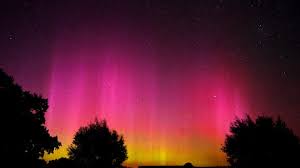Increased Solar Flares Signal Prime Viewing Conditions for Aurora Borealis
A recent geomagnetic storm provides a chance for many lucky Americans to witness the stunning northern lights, or aurora borealis, this week. The phenomenon follows the observation of the second-largest solar flare in the current solar cycle on Tuesday, which was marked by a significant X7.1 solar flare, according to the National Oceanic and Atmospheric Administration’s (NOAA) Space Weather Prediction Center.
The NOAA has issued geomagnetic storm watches ranging from minor to strong levels, forecasting the visibility of the northern lights from October 3 through October 5. Last week, forecasts indicated that the auroras could be seen across the northwestern U.S. and parts of the Midwest, showcasing vibrant displays of greens and reds.
In May, a powerful geomagnetic storm resulted in spectacular aurora sightings in areas that usually don’t experience such events, although it also caused some power grid irregularities and interference with GPS signals.
Where to See the Northern Lights
The northern lights are expected to be visible across various northern U.S. states between October 3 and October 5, particularly along the U.S.-Canada border and as far south as Pennsylvania and Oregon. The optimal time for viewing is anticipated to be the early hours of Friday, October 4, around midnight local time.
The NOAA warns that the forecast is subject to uncertainty due to the unpredictable nature of solar eruptions. Auroras may range from bright displays high in the sky to faint glows near the northern horizon, potentially only visible with long-exposure camera shots.
Increased Aurora Activity
With the sun nearing the peak of its 11-year solar cycle, more frequent and vibrant northern lights are expected. NASA predicts that Solar Cycle 25 will reach its peak in 2025, increasing electromagnetic activity. This heightened activity is associated with solar flares, the largest explosive events in our solar system.
Solar flares emit radiation in various forms, including ultraviolet light and X-rays, which can travel to Earth at the speed of light. These flares may be accompanied by coronal mass ejections (CMEs) that disrupt Earth’s magnetosphere, leading to geomagnetic storms that create the conditions for auroras.
What Causes the Auroras?
The auroras are a natural light display predominantly visible in high-latitude regions of the northern and southern hemispheres. They occur when charged particles from space collide with gases in Earth’s atmosphere, such as oxygen and nitrogen. This interaction energizes atmospheric particles, which release energy in the form of light, creating beautiful displays of rays, spirals, and flickers.
The colors observed in auroras—green, red, blue, and pink—depend on the altitude of the collisions and the composition and density of the atmosphere at that time.
Best Viewing Locations
The best locations for observing the northern lights are around the magnetic poles, particularly in Europe, Asia, and North America. Alaska is renowned for its ideal viewing conditions in the U.S. Although forecasts for aurora displays are improving, predicting the precise timing and location of these phenomena remains challenging.
For the best viewing experience, skygazers should seek dark areas away from city lights. Clear weather conditions enhance visibility, with the best opportunities usually occurring within one to two hours of midnight.
NOAA maintains an aurora dashboard that can help enthusiasts track potential sightings.
Northern Lights Viewing in Iceland
In Iceland, the northern lights can be observed both day and night year-round, although it is advisable to go skygazing a few hours before midnight. The prime season for aurora viewing is from September to April.
Viewing Without Equipment
Northern lights can be observed with the naked eye, making them accessible to anyone without the need for telescopes or microscopes. Visibility can depend on factors such as location, weather, time of night, and the level of geomagnetic activity.
For more updates on this phenomenon, stay tuned to NOAA and local news sources.






